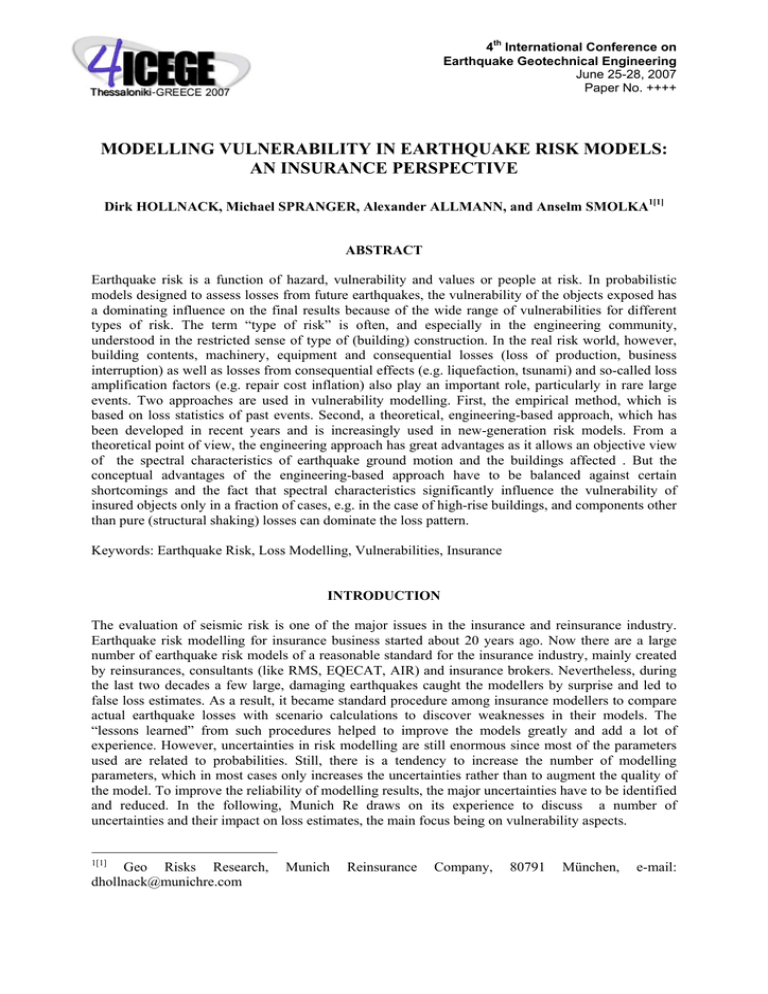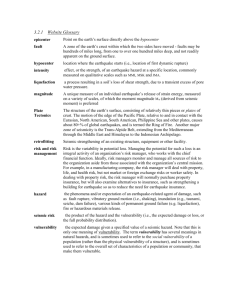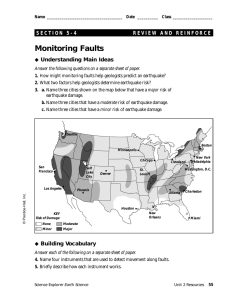MODELLING VULNERABILITY IN EARTHQUAKE RISK MODELS: AN INSURANCE PERSPECTIVE
advertisement

4th International Conference on Earthquake Geotechnical Engineering June 25-28, 2007 Paper No. ++++ MODELLING VULNERABILITY IN EARTHQUAKE RISK MODELS: AN INSURANCE PERSPECTIVE Dirk HOLLNACK, Michael SPRANGER, Alexander ALLMANN, and Anselm SMOLKA1[1] ABSTRACT Earthquake risk is a function of hazard, vulnerability and values or people at risk. In probabilistic models designed to assess losses from future earthquakes, the vulnerability of the objects exposed has a dominating influence on the final results because of the wide range of vulnerabilities for different types of risk. The term “type of risk” is often, and especially in the engineering community, understood in the restricted sense of type of (building) construction. In the real risk world, however, building contents, machinery, equipment and consequential losses (loss of production, business interruption) as well as losses from consequential effects (e.g. liquefaction, tsunami) and so-called loss amplification factors (e.g. repair cost inflation) also play an important role, particularly in rare large events. Two approaches are used in vulnerability modelling. First, the empirical method, which is based on loss statistics of past events. Second, a theoretical, engineering-based approach, which has been developed in recent years and is increasingly used in new-generation risk models. From a theoretical point of view, the engineering approach has great advantages as it allows an objective view of the spectral characteristics of earthquake ground motion and the buildings affected . But the conceptual advantages of the engineering-based approach have to be balanced against certain shortcomings and the fact that spectral characteristics significantly influence the vulnerability of insured objects only in a fraction of cases, e.g. in the case of high-rise buildings, and components other than pure (structural shaking) losses can dominate the loss pattern. Keywords: Earthquake Risk, Loss Modelling, Vulnerabilities, Insurance INTRODUCTION The evaluation of seismic risk is one of the major issues in the insurance and reinsurance industry. Earthquake risk modelling for insurance business started about 20 years ago. Now there are a large number of earthquake risk models of a reasonable standard for the insurance industry, mainly created by reinsurances, consultants (like RMS, EQECAT, AIR) and insurance brokers. Nevertheless, during the last two decades a few large, damaging earthquakes caught the modellers by surprise and led to false loss estimates. As a result, it became standard procedure among insurance modellers to compare actual earthquake losses with scenario calculations to discover weaknesses in their models. The “lessons learned” from such procedures helped to improve the models greatly and add a lot of experience. However, uncertainties in risk modelling are still enormous since most of the parameters used are related to probabilities. Still, there is a tendency to increase the number of modelling parameters, which in most cases only increases the uncertainties rather than to augment the quality of the model. To improve the reliability of modelling results, the major uncertainties have to be identified and reduced. In the following, Munich Re draws on its experience to discuss a number of uncertainties and their impact on loss estimates, the main focus being on vulnerability aspects. 1[1] Geo Risks Research, dhollnack@munichre.com Munich Reinsurance Company, 80791 München, e-mail: EARTHQUAKE RISK MODELLING FOR INSURANCES The structure of earthquake risk models varies, depending on whether they are meant for disaster management, lifeline analysis, emergency information, economic or insured losses. Models can be meant to estimate building damage, financial loss or mortality. Insurance models are mainly used to calculate two parameters for a certain liability distribution (portfolios): the Average Annual Loss (AAL) and the Probable Maximum Loss (PML). The AAL, also called technical rate, is the basis for determining the insurance premium. The PML, on the other hand, defines the maximum insured loss for a given value distribution and time period, which is normally in the range between 250 and 1,000 years for earthquakes, and is an important parameter for financial aspects of risk management of (re)insurances. Munich Re started probabilistic risk modelling in 1987, at a time when seismic risk models existed only for site-specific studies. To date Munich Re uses proprietary earthquake models for 26 different countries. These models are part of Munich Re’s pricing tool and therefore an key part of daily business. They are applied a lot by many different users, who are normally not earthquake specialists. Therefore, the tool has to be easy to use and the operating time for a model run has to be as short as possible. In general, probabilistic earthquake risk models used by the insurance industry have a similar configuration. The models are normally made up of three main modules: the seismic hazard part, the vulnerability part, and a module which governs the values at risk, often called the financial module (Fig. 1). Figure 1. Scheme of the risk modelling procedure used by Munich Re The financial module also handles the input data, i.e. the portfolio information transferred to the reinsurer by the client. This exchange of data is regulated by certain standards, which have an important impact on the assembly and resolution of insurance-related models and hence need to be explained. In most cases, insurance portfolios include a huge number of buildings, distributed all over the country. To reduce the amount of data to be transferred and processed, the insured values and locations of insured risks are aggregated to so-called CRESTA zones (Catastrophe Risk Evaluating and Standardizing Target Accumulations). CRESTA was set up by the insurance industry in 1977 as an independent organisation with the aim of working out a uniform format for the processing and electronic transfer of accumulation risk data between insurance and reinsurance companies. For this purpose, they determine country-specific zones for the technical management of natural hazard coverage. What was a very good approach in 1977 turns out to be a disadvantage today since it is difficult and takes a lot of time to implement changes within insurance markets. Therefore, the zoning structure for many countries does not meet the requirements of today’s modelling technology. Figure 2 shows the CRESTA zones for Greece, subdividing the country into only 16 accumulation regions. The accumulated values of the insured risks per zone are generally split up into three different lines of business, which are residential, commercial and industrial, each of which can be broken down further into building, contents and business interruption. More specific lines of business are only rarely used. Figure 2. CRESTA zones for Greece (from www.cresta.org) In Munich Re models, the hazard module is mainly based on a classic PSHA approach as established by Cornell (1968) and described in its enhanced form for example by Kramer (1996) or McGuire (2004). If available, complete hazard analyses representing the current state of scientific knowledge are taken to generate a complete probabilistic event set for the respective country. During modelling, the seismicity, which can be based on area zones as well as on fault zones, is simulated by scenario calculations running from a minimum magnitude (start of damage) up to the maximum magnitude in 0.1 magnitude steps. Using regional attenuation equations and taking soil conditions into account, the ground motions at all potentially effected sites are computed. Up to now, the ground motion is given in terms of MMI intensity only. The resulting intensities at the liability sites are passed to the vulnerability module, which mainly consists of a set of mean loss curves. Each of these curves specifies the country-related loss percentage for a defined line of business and given intensity. This can be directly converted into monetary loss and, under consideration of the insurance conditions like limits and deductibles, into insured losses. The resulting losses at all liability sites are added up to give a total scenario loss, which is stored together with an event ID and the event probability. Finally, the PML curve is created by sorting the events by losses and cumulating the probabilities (Fig. 3). Figure 3. Example of a PML curve UNCERTAINTIES IN RISK MODELLING Hazard Uncertainty is related to each single part of risk modelling. The important question from the insurance point of view is: Which uncertainties have the largest impact on loss, PML and AAL calculations and how can they be reduced or even eliminated? Reviewing the loss experience from big earthquakes during the last two decades indicates that the influence of hazard-related uncertainties is highly variable and depends on seismicity. In regions with a small historical record and/or weak to moderate earthquake activity, the hazard uncertainties are quite large. Most recent events were part of the probabilistic event sets. Athens 1999, Newcastle 1989, Chi-Chi 1999, and the surprisingly high magnitude (including the tsunami) of the 2004 Sumatra earthquake may be regarded as exceptions. On the other hand, it is extremely difficult to prove whether such unlikely events are used in the models with adequate probabilities. In most regions, the historical record is too short for sound statistical tests. Nevertheless, in some cases the definition of the return of large historical events is of concern, especially if different opinions result in different recurrence estimates over all magnitudes. Examples of this might be Lisbon and New Madrid. Disregarding aleatory uncertainties, which are related to the unpredictability of the earthquake generating process, the main parameter for ground motion calculations for a given magnitude and focal mechanism are attenuation equations and site conditions. Especially the impact of most site effects is hard to assess. While it is quite common to take into account the influence of soil conditions in risk modelling, the impact of site density (neighbouring effects) and topographic effects is insufficiently known, whereas the susceptibilities towards liquefaction and landslides are complex and increase the amount of uncertainties. Nevertheless, the quality of ground motion modelling can be controlled by comparing scenario calculations from the model and observed ground motions, which are increasingly offered via the internet. But it has to be kept in mind that due to site effects like the probability for surprises in loss modelling increases with the size of the catastrophe. Vulnerability In the main, two vulnerability approaches are used in earthquake risk modelling: the empirical and the theoretical or analytical method. Some authors (i.e. Giovinazzi, 2005) maintain that the method based on expert judgement is an individual approach. This methodology was used, for example, by the Applied Technology Council and published as ATC13 (1987) report. The empirical method is based on statistical observations of damage data of past events as a function of the intensity. Nevertheless, it is a simple and effective way of providing an estimate of mean damage to large building stocks that largely meets the requirements of insurance industry. Sauter and Shah (1978) and Sauter (1979) presented mean damage curves for different building types based on an empirical method that were frequently used in risk modelling (Fig. 4). Figure 4. Mean damage curves after Sauter (1979) Due to the fact that detailed statistical results of damage and loss patterns from post-earthquake reconnaissance projects are rarely published, only few verifications of these curves were published in the aftermath. The main disadvantage of this method is that the seismic loading is expressed as intensity, which is a subjective parameter. On the other hand, it allows inclusion of amplifying and other secondary effects in the vulnerability curves, which is cumbersome using the theoretical method, see below. Additionally, this method is unsuitable for assessing damage to individual buildings. The theoretical approach is mainly based on fragility curves, which are derived from the combination of seismic demand and construction-specific capacity curves. The engineering approach has the advantage that it allows an objective consideration of the spectral characteristics of earthquake ground motion and the affected building. Laboratory experiments are used to test the damage behaviour of structures and their components. This offers a lot of flexibility in predicting damage. By modifying the different factors, one can consider many combinations of structural systems, construction types and materials (Sauter, 1979, Giovinazzi, 2005). But from this flexibility also result a number of shortcomings. Small verifications of buildings can lead to large differences in response and deformation and thus change the degree of damage. It follows that a consistent implementation of this method requires a very detailed inspection of each single building, which is very time-consuming, expensive and in most cases not practicable for insurance purposes. This is quite frequently done in scientific risk models. In many cases, complete building stocks of large cities are reproduced within the model by each individual structure. Such models require enormous computer capacities and long run times, up to several days per program run. A challenge is, however, that verifying model results against empirical losses from past events is difficult, as only very few corresponding loss data have been collected so far, and the rich loss experience from older events is lost for plausibility testing. Up to now very few “high-resolution” modelling results have been published, and experience-based comparisons with real earthquake damage barely exist. This makes it very difficult to assess the quality and preciseness of this approach. In the majority of cases, high-resolution data for a single building approach are not available, which means large simplifications have to be introduced, idealising the building characteristics. As a result, the predicted damage for a given ground motion will be the same for all buildings of the same type. But this is contradictory to observed earthquake damage patterns which demonstrate that neighbouring buildings of the same type quite often show completely different degrees of damage. This makes it difficult to provide a good estimate of minor or non-structural damage. Such non-structural damage, mainly related to small intensities, are a driving component for the AAL. Figure 5 shows a PML curve analysis, indicating that 55% of the insurance rate comes from intensities between VI and VII. The seismic loading can be expressed as PGA, PGV or PGD, which are instrumentally measured and therefore “objective” parameters. But deciding on what parameter to use for which cases is still a matter of discussion. On the other hand, it is not enough to use only the measured PGA values, the most common parameter in engineering, as demonstrated in recent earthquakes where surprisingly high PGA values were measured (i.e. Niigata 2004). Furthermore, the correlation between damage and PGA seems to be rather poor, as seen with the Western Tottori (2000) earthquake, where hardly any damage occurred in regions with PGAs of more than 1g. 0.1 1 0.09 0.9 0.8 AAL 0.07 0.7 AAL_cumulative 0.06 0.6 0.05 0.5 0.04 0.4 0.03 0.3 0.02 0.2 0.01 0.1 0 acumulated Contributin to AAL relative Contribution to AAL 0.08 0 6 7 8 9 10 MMI Figure 5. Contribution of different intensity levels to the AAL CONCLUSIONS The greatest uncertainties in seismic risk modelling are related to secondary effects and vulnerabilities. Monetary losses after large earthquakes are quite often driven by effects such as production losses or repair cost inflation (demand surge) rather than by pure building damage. The theoretical vulnerability approach implies a lot of advantages. However, given the current state of knowledge, this approach is difficult to implement in risk modelling without increasing the uncertainties as it requires many parameters on a very detailed level. In most cases, this level of data quality is not available, especially not for insurances. A hybrid approach combining the advantages of both vulnerability methods appears to be the best solution as regards the current state of knowledge. On the other hand, an improvement of data quality in insurance business is necessary to produce more precise models. What level of data resolution, as far as spatial distribution and building details are concerned, provides the most reliable results in modelling has not yet been solved. It is possible that an increasing number of parameters and information leads to higher uncertainties and more inaccurate results. To find an answer to this question, more reconnaissance projects are needed. Only a comparison between modelled losses with real damage patterns and the lessons to be learned from this will lead to an improvement of risk modelling strategies as well as to more reliability in modelling results. Differences between modelled and real losses, as seen from recent large earthquakes, mainly resulted from unforeseen effects that were considered neither in the ground motion calculations nor in the vulnerability curves. Those effects are not only restricted to secondary effects like liquefaction and soil amplification. Against the background of increasing globalisation, economic and social components like demand surge or repair cost inflation as well as business interruption or loss of production are increasingly becoming the driving factors for monetary earthquake losses. The current gap between damage estimates and loss calculation is quite large. Chi-Chi 1999 is a prominent example of an earthquake resulting in surprisingly high business interruption losses as opposed to building damage. Even though Katrina in 2005 was a hurricane, the unforeseen losses from this natural catastrophe should be adopted as lessons learned to improve earthquake risk modelling. REFERENCES ATC 13. “Earthquake damage evaluation data for California,” Applied Technology Council, Redwood City, California, 1987 Giovinazzi S. “The Vulnerability Assessment and the Damage Scenario in Seismic Risk Analysis,” Dissertation, Department of Civil Engineering, Technical University at Braunschweig, 199pp., 2005 Kramer SL. “Geotechnical Earthquake Engineering,” Englewood Cliffs, NJ: Prentice Hall, 653pp., 1996 McGuire RK. “Seismic Hazard and Risk Analysis,” EERI Publications No. MNO-10, Oakland, CA, 221pp., 2004 Sauter F. “Damage Prediction for Earthquake Insurance,” Proc. 2nd US Nat. Conf. Earthqu. Eng., pp. 99–108, 1979 Sauter F and Shah HC. “Studies on Earthquake Insurance,” Proceedings, Central American Conference on Earthquake Engineering, Vol. II, El Salvador, 1978








